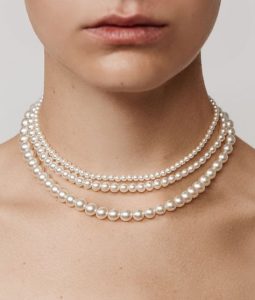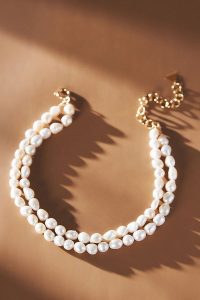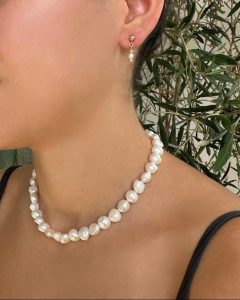Pearl necklaces are a classic and elegant piece of jewelry that have been worn for centuries. They come in a variety of styles, colors, and sizes, making them a versatile accessory that people can dress up or down.
This article will delve into the world of necklaces, exploring their history, different types, and how to style them.
The History of Pearl Necklaces: From Ancient Times to Modern Day
Pearls are natural gemstones formed inside oysters and mollusks. Since they are found underwater, pearls have been associated with mystery and beauty for centuries.
Early Origins:
Evidence suggests people have been wearing pearls for thousands of years. People found pearls in archaeological digs dating back to ancient civilizations like Persia and Egypt.
A Symbol of Status:
Throughout history, people consider pearls as a symbol of wealth and status. Royalty and nobility often adorned themselves with pearl jewelry.
Cultured Pearls Make Pearls More Accessible:
In the early 20th century, the development of cultured pearls made pearl jewelry more affordable. Cultured pearls are formed when a substance is inserted into a mollusk, stimulating it to produce a pearl.
Today, pearl necklaces remain a popular jewelry choice. People of all ages and styles like them.
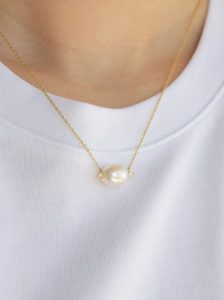
The Different Types of Pearl Necklaces
There are many different types of pearl necklaces to choose from. Here are some of the most popular:
-
Akoya Pearls: Akoya pearls is famous for their high luster and white or cream color. They are typically smaller in size and are often strung together in a single strand.
-
South Sea Pearls: South Sea pearls are famous for their large size and golden or rose overtones. People use them in statement necklaces.
-
Tahitian Pearls: Tahitian pearls, also known as black pearls, come in a variety of dark colors, including black, gray, and green. People can use them to create dramatic and unique necklaces.
-
Freshwater Pearls: Freshwater pearls are the most affordable type of pearl. They come in a variety of colors and shapes, and people can use it to create casual or dressy necklaces.
In addition to the type of pearl, the clasp and length of the necklace can also vary. Some necklaces have a simple clasp, while others may have a more decorative clasp that is part of the design. The length of the necklace can range from a choker to a long strand that reaches the waist.
Styling Your Pearl Necklace: Pearls for Every Occasion
Pearl necklaces are a versatile accessory that can be dressed up or down. Here are some tips for styling your pearl necklace:
-
For a Classic Look: A single strand of Akoya pearls is a timeless and elegant choice. This type of necklace can be worn with a dress for a formal event or with a blouse and skirt for a more casual look.
-
For a Modern Look: A Tahitian pearl necklace with a black or gray pearl can add a touch of edge to your outfit. This type of necklace can be worn with jeans and a T-shirt or with a cocktail dress.
-
For a Summery Look: A freshwater pearl necklace in a pastel color can add a touch of femininity to your summer outfit. This type of necklace is with a sundress or with a casual outfit.
-
Layering Necklaces: Pearl necklaces can also be layered with other necklaces to create a more unique look. For example, you could layer a long strand of freshwater pearls with a shorter strand of Akoya pearls.
No matter how you choose to style it, a pearl necklace is a sure way to add a touch of sophistication and elegance to your outfit.
Caring for Your Pearl Necklace
Like all jewelry, pearl necklaces need to care for to keep them looking their best. Here are some tips for caring for your pearl necklace:
-
Store Your Necklace Properly: When you are not wearing your pearl necklace, store it in a soft pouch or jewelry box. This will help to protect it from scratches and other damage.
-
Wipe Your Necklace Clean: After wearing your pearl necklace, wipe it clean with a soft, damp cloth. This will remove any dirt or perspiration that could damage the pearls.
-
Avoid Harsh Chemicals: Avoid exposing your pearl necklace to harsh chemicals, such as perfume, hairspray, and lotion. These chemicals can damage the pearls over time.
-
Have Your Necklace Restrung Regularly: Over time, the string on your pearl necklace may wear out. It is important to have your necklace restrung every few years to prevent the pearls from falling out.
By following these tips, you can ensure that your pearl necklace will last for years to come.
The Luster and Allure of Pearls
Pearls come in a variety of colors, but they all share a unique and beautiful sheen called luster. This luster is what gives pearls their characteristic iridescence and makes them so visually appealing. Here’s a closer look at the factors affecting a pearl’s luster:
-
Nacre Thickness: Nacre is the layer of material that mollusks deposit around an irritant to create a pearl. The thicker the nacre layer, the higher the luster of the pearl.
-
Surface Quality: A smooth and blemish-free surface will reflect light better, resulting in higher luster.
-
Shape: Perfectly round pearls are rare and tend to have higher luster. However, baroque pearls with unique shapes can also be very lustrous.
The combination of these factors determines a pearl’s overall quality and value. However, luster isn’t everything. Many factors come into play when choosing a pearl necklace, and the most important thing is to find a piece that you love and that complements your style.
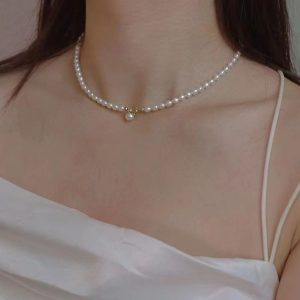
Conclusion
Pearl necklaces are a classic and versatile piece of jewelry. With their timeless elegance and natural beauty, pearl necklaces are sure to remain a popular jewelry choice for years to come. Whether you’re looking for a single strand of Akoya pearls for a formal event or a colorful freshwater pearl necklace for a summer day, there’s a pearl necklace out there to perfectly complement your style. And with proper care, your pearl necklace can become a cherished piece that you treasure for years to come.

